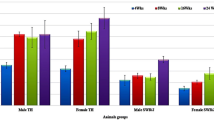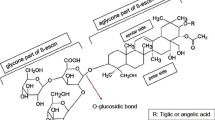Abstract
Progressive decline of islet β cell mass is a hallmark of type 2 diabetes, where nutritional insults are invoked in the pathologic process. Its detailed mechanisms are, however, incompletely understood. We explored the effect of sucrose diet on mitochondria in Goto Kakizaki (GK) rats, a spontaneously diabetic model. Six-week-old male GK rats were given 30% sucrose orally for 2 weeks. Normal Wistar rats fed with sucrose served as controls. Compared to untreated GK rats, sucrose-fed GK rats showed severe degeneration and death of β cells with disrupted and swollen mitochondria and a greater β cell loss. Submicroscopic analysis disclosed a smaller mean volume and a greater number of mitochondria in β cells in GK rats compared to those in Wistar rats. Mitochondria in sucrose-fed GK rats were 2.4-fold greater in mean volume than those in untreated state. Without sucrose feeding, there was no significant difference in mitochondrial membrane potentials (MmPs) of isolated islets between Wistar and GK rats. MmPs were reduced by 44% in sucrose-fed GK rats but not influenced in sucrose-fed Wistar rats. Current results suggest that nutritional insults like sucrose feeding may exert deleterious effects on mitochondria, resulting in augmented β cell loss in type 2 diabetes.






Similar content being viewed by others
References
Abdel-Halim SM, Guenifi A, He B, Yang B, Mustafa M, Hojeberg B, Hillert J, Bakhiet M, Efendic S (1998) Mutations in the promoter of adenylyl cyclase (AC)-III gene, overexpression of AC-III mRNA, and enhanced cAMP generation in islets from the spontaneously diabetic GK rat model of type 2 diabetes. Diabetes 47:498–504
Briaud I, Kelpe CL, Johnson LM, Tran PO, Poitout V (2002) Differential effects of hyperlipidemia on insulin secretion in islets of Langerhans from hyperglycemic versus normoglycemic rats. Diabetes 51:662–668
Daugas E, Susin SA, Zamzami N, Ferri KF, Irinopoulou T, Larochette N, Prevost MC, Leber B, Andrews D, Penninger J, Kroemer G (2000) Mitochondrial-nuclear translocation of AIF in apoptosis and necrosis. FASEB J 14:729–739
Dolz M, Bailbe D, Giroix MH, Calderari S, Gangnerau MN, Serradas P, Rickenbach K, Irminger JC, Portha B (2005) Restitution of defective glucose-stimulated insulin secretion in diabetic GK rat by acetylcholine uncovers paradoxical stimulatory effect of beta-cell muscarinic receptor activation on cAMP production. Diabetes 54:3229–3237
Donath MY, Ehses JA, Maedler K, Schumann DM, Ellingsgaard H, Eppler E, Reinecke M (2005) Mechanisms of β-cell death in type 2 diabetes. Diabetes 54(Suppl 2):S108–S113
Emaus RK, Grunwald R, Lemasters JJ (1986) Rhodamine 123 as a probe of transmembrane potential in isolated rat-liver mitochondria: spectral and metabolic properties. Biochim Biophys Acta 850:436–448
Eto K, Tsubamoto Y, Terauchi Y, Sugiyama T, Kishimoto T, Takahashi N, Yamauchi N, Kubota N, Murayama S, Aizawa T, Akanuma Y, Aizawa S, Kasai H, Yazaki Y, Kadowaki T (1999) Role of NADH shuttle system in glucose-induced activation of mitochondrial metabolism and insulin secretion. Science 283:981–985
Fex M, Nitert MD, Wierup N, Sundler F, Ling C, Mulder H (2007) Enhanced mitochondrial metabolism may account for the adaptation to insulin resistance in islets from C57BL/6J mice fed a high fat diet. Diabetologia 50:74–83
Goto Y, Kakizaki M, Masaki N (1975) Spontaneous diabetes produced by selective breeding of normal Wistar rats. Proc Jpn Acad 51:80–85
Goto Y, Suzuki K, Ono T, Sasaki M, Toyota T (1988) Development of diabetes in the non-obese NIDDM rat (GK rat). Adv Exp Med Biol 246:29–31
Gross DJ, Leibowitz G, Cerasi E, Kaiser N (1996) Increased susceptibility of islets from diabetes-prone Psammomys obesus to the deleterious effects of chronic glucose exposure. Endocrinology 137:5610–5615
Guenifi A, Abdel-Halim SM, Hoog A, Falkmer S, Östenson CG (1995) Preserved β-cell density in the endocrine pancreas of young, spontaneously diabetic Goto-Kakizaki (GK) rats. Pancreas 10:148–153
Kim JS, He L, Lemasters JJ (2003) Mitochondria permeability transition: a common pathway to necrosis and apoptosis. Biochem Biophys Res Comm 304:463–470
Kobayashi T, Nakanishi K, Nakase H, Kajio H, Okubo M, Murase T, Kosaka K (1997) In situ characterization of islets in diabetes with a mitochondrial DNA mutation at nucleotide position 3243. Diabetes 46:1567–1571
Koyama M, Wada R, Mizukami H, Sakuraba H, Odaka H, Ikeda H, Yagihashi S (2000) Inhibition of progressive reduction of islet β-cell mass in spontaneously diabetic Goto-Kakizaki rats by α-glucosidase inhibitor. Metabolism 49:1–7
Koyama M, Wada R, Sakuraba H, Mizukami H, Yagihashi S (1998) Accelerated loss of islet β cells in sucrose-fed Goto-Kakizaki rats, a genetic model of non-insulin-dependent diabetes mellitus. Am J Pathol 153:537–545
Krauss S, Zhang CY, Scorrano L, Dalgaard LT, St-Pierre J, Grey ST, Lowell BB (2003) Superoxide-mediated activation of uncoupling protein 2 causes pancreatic beta cell dysfunction. J Clin Invest 112:1831–1842
Lacy PE, Kostianovsky M (1967) Method for the isolation of intact islets of Langerhans from the rat pancreas. Diabetes 16:35–39
Lee Y, Hirose H, Ohneda M, Johnson JH, McGarry JD, Unger RH (1994) β-cell lipotoxicity in the pathogenesis of non-insulin-dependent diabetes mellitus of obese rats: impairment in adipocyte-β-cell relationships. Proc Natl Acad Sci U S A 91:10878–10882
Leonard JV, Schapira AHV (2000) Mitochondrial respiratory chain disorders II: neurodegenerative disorders and nuclear gene defects. Lancet 355:389–394
Lowell BB, Schulman GI (2005) Mitochondrial dysfunction in type 2 diabetes. Science 307:384–387
Odaka H, Sugiyama Y, Ikeda H (1991) Effect of pioglitazone on sucrose-deteriorated diabetic states in spontaneously diabetic GK rats. J Jpn Diab Soc 34:523–530
Östenson C-G, Abdel-Halim SM, Andersson A, Guenifi A, Khan A, Larsson O, Berggren PO, Efendic S (1996) Studies on the pathogenesis of NIDDM in the GK (Goto-Kakizaki) rat. In: Shafrir E (ed) Lessons from animal diabetes, VI. Birkhäuser, Boston, pp 299–315
Östenson CG, Khan A, Abdel-Halim SM, Guenifi A, Suzuki K, Goto Y, Efendic S (1993) Abnormal insulin secretion and glucose metabolism in pancreatic islets from the spontaneously diabetic GK rat. Diabetologia 36:3–8
Otabe S, Yasuda K, Mori Y, Shimokawa K, Kadowaki H, Jimi A, Nonaka K, Akanuma Y, Yazaki Y, Kadowaki T (1999) Molecular and histological evaluation of pancreata from patients with a mitochondrial gene mutation associated with impaired insulin secretion. Biochem Biophys Res Commun 259:149–156
Portha B, Giroix MH, Picon L (1982) Effect of diet on glucose tolerance and insulin response in chemically diabetic rats. Metabolism 31:1194–1199
Portha B, Serradas P, Bailbe D, Suzuki K, Goto Y, Giroix MH (1991) β-cell insensitivity to glucose in the GK rat, a spontaneous non-obese model for type II diabetes. Diabetes 40:486–491
Reiser S, Michaelis O IV, Putney J, Hallfrisch J (1975) Effects of sucrose feeding on the intestinal transport of sugars in two strains of rats. J Nutr 105:894–905
Rhodes CJ (2005) Type 2 diabetes: a matter of beta-cell life and death? Science 307:380–384
Robertson RP, Harmon J, Tran PO, Poitout V (2003) Glucose toxicity in beta-cells: type 2 diabetes, good radicals gone bad, and the glutathione connection. Diabetes 52:581–587
Sakuraba H, Mizukami H, Yagihashi N, Wada R, Hanyu C, Yagihashi S (2002) Reduced beta-cell mass and expression of oxidative stress-related DNA damage in the islet of Japanese Type II diabetic patients. Diabetologia 45:85–96
Santos MS, Santos DL, Palmeira CM, Seica R, Moreno AJ, Oliveira CR (2001) Brain and liver mitochondria isolated from diabetic Goto-Kakizaki rats show different susceptibility to induced oxidative stress. Diabetes Metab Res Rev 17:223–230
Serradas P, Giroix MH, Saulnier C, Gangnerau MN, Borg LA, Welsh M, Portha B, Welsh N (1995) Mitochondrial deoxyribonucleic acid content is specifically decreased in adult, but not fetal, pancreatic islets of the Goto-Kakizaki rat, a genetic model of non-insulin-dependent diabetes. Endocrinology 136:5623–5631
Tiedge M, Lortz S, Drinkgern J, Lenzen S (1997) Relation between antioxidant enzyme gene expression and antioxidative defense status of insulin-producing cells. Diabetes 46:1733–1742
Vallerand AL, Lupien J, Bukowiecki LJ (1986) Synergistic improvement of glucose intolerance by sucrose feeding and exercise training. Am J Physiol 250:E607–E614
Wu L, Nicholson W, Knobel SM, Steffner RJ, May JM, Piston DW, Powers AC (2004) Oxidative stress is a mediator of glucose toxicity in insulin-secreting pancreatic islet cell lines. J Biol Chem 279:12126–12134
Yang S, Zhu H, Li Y, Lin H, Gabrielson K, Trush MA, Diehl AM (2000) Mitochondrial adaptations to obesity-related oxidant stress. Arch Biochem Biophys 378:259–268
Acknowledgment
This study was not possible without the kind supply of GK rats from Drs. Hitoshi Ikeda and Hiroyuki Odaka, Research Institute, Takeda Pharmaceuticals. The authors are indebted to Ms. Yuko Sasaki for her expert technical assistance. This study was supported by grants to Soroku Yagihashi from the Ministry of Education, Science, Sports and Culture, Japan.
Author information
Authors and Affiliations
Corresponding author
Rights and permissions
About this article
Cite this article
Mizukami, H., Wada, R., Koyama, M. et al. Augmented β cell loss and mitochondrial abnormalities in sucrose-fed GK rats. Virchows Arch 452, 383–392 (2008). https://doi.org/10.1007/s00428-007-0508-2
Received:
Revised:
Accepted:
Published:
Issue Date:
DOI: https://doi.org/10.1007/s00428-007-0508-2




